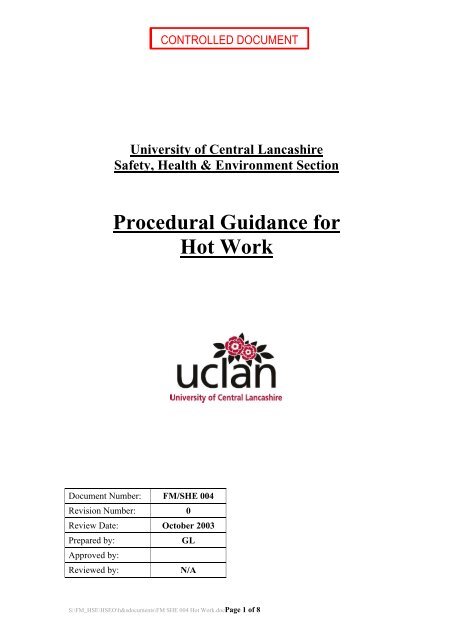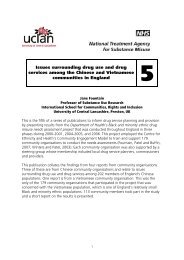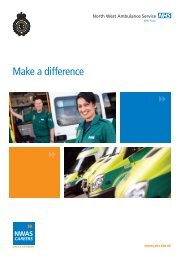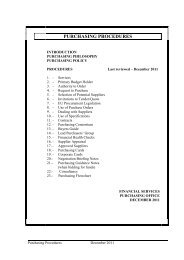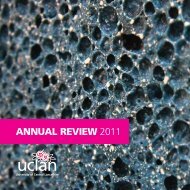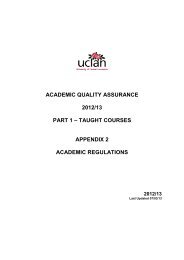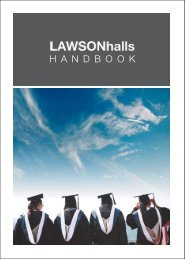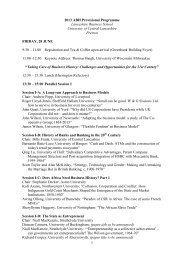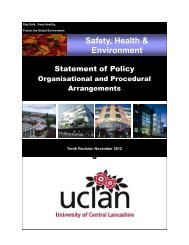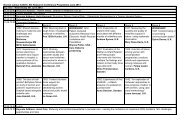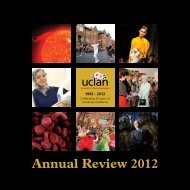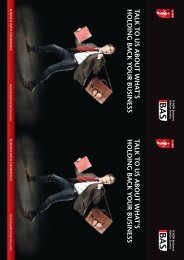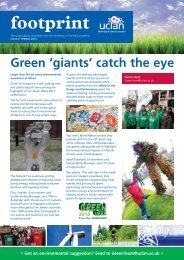Procedural Guidance for Hot Work - University of Central Lancashire
Procedural Guidance for Hot Work - University of Central Lancashire
Procedural Guidance for Hot Work - University of Central Lancashire
Create successful ePaper yourself
Turn your PDF publications into a flip-book with our unique Google optimized e-Paper software.
CONTROLLED DOCUMENT<br />
<strong>University</strong> <strong>of</strong> <strong>Central</strong> <strong>Lancashire</strong><br />
Safety, Health & Environment Section<br />
<strong>Procedural</strong> <strong>Guidance</strong> <strong>for</strong><br />
<strong>Hot</strong> <strong>Work</strong><br />
Document Number: FM/SHE 004<br />
Revision Number: 0<br />
Review Date: October 2003<br />
Prepared by:<br />
GL<br />
Approved by:<br />
Reviewed by:<br />
N/A<br />
S:\FM_HSE\HSEO\h&sdocuments\FM SHE 004 <strong>Hot</strong> <strong>Work</strong>.docPage 1 <strong>of</strong> 8
CONTROLLED DOCUMENT<br />
Section Contents Page<br />
1.0 Introduction 3<br />
2.0 Scope 3<br />
3.0 Purpose 3<br />
4.0 Definitions 3<br />
5.0 Legal Requirements 3<br />
6.0 Hazards 3<br />
6.1 Burns 4<br />
6.2 Eye Damage 4<br />
6.3 Fire 4<br />
6.4 Welding Fume 4<br />
6.5 Explosions 4<br />
6.6 Hazards arising out <strong>of</strong> work activity 4<br />
7.0 Procedure 5<br />
7.1 Risk Assessment 5<br />
7.2 Permit to <strong>Work</strong> 5<br />
7.3 Precautions <strong>for</strong> <strong>Hot</strong> <strong>Work</strong> 6<br />
8.0 Emergency Arrangements 7<br />
9.0 Training and Supervision 7<br />
10.0 Summary <strong>of</strong> Responsibilities. 8<br />
11.0 Further <strong>Guidance</strong> 8<br />
APPENDICES<br />
S:\FM_HSE\HSEO\h&sdocuments\FM SHE 004 <strong>Hot</strong> <strong>Work</strong>.docPage 2 <strong>of</strong> 8
CONTROLLED DOCUMENT<br />
1.0 Introduction<br />
Most hot work operations involve a number <strong>of</strong> parties, all <strong>of</strong> whom have<br />
responsibilities <strong>for</strong> ensuring that the work is carried out safely. Contractors and/or<br />
maintenance staff must consult and liase with the departmental staff in the area that<br />
the hot work is to be per<strong>for</strong>med.<br />
2.0 Scope<br />
This procedure applies to all hot work on <strong>University</strong> premises that poses a risk to<br />
employees, students, visitors, contractors and members <strong>of</strong> the public.<br />
3.0 Purpose<br />
The purpose <strong>of</strong> this procedure is to ensure that:<br />
hot work is identified;<br />
when hot work is per<strong>for</strong>med, all hazards have been considered and there are<br />
sufficient safe systems <strong>of</strong> work and emergency arrangements in place to<br />
reduce the risk <strong>of</strong> injury;<br />
there is no contact between sparks, flame or heat, and fuel sources;<br />
compliance with relevant legislation.<br />
4.0 Definitions<br />
<strong>Hot</strong> work: The use <strong>of</strong> open fires, flames and work involving the application <strong>of</strong> heat by<br />
means <strong>of</strong> tools or equipment. This includes the unintentional application <strong>of</strong> heat by<br />
the use <strong>of</strong> power tools, hot rivets or hot particles generated from cutting or welding<br />
operations.<br />
The sources <strong>of</strong> heat most commonly involved include:<br />
gas/electric welding and cutting apparatus;<br />
blow torches/blowlamps;<br />
bitumen/tar boilers;<br />
grinding wheels and cutting disks.<br />
5.0 Legal requirements<br />
5.1 The Management <strong>of</strong> Health and Safety at <strong>Work</strong> Regulations 1999.<br />
An assessment <strong>of</strong> the risks in all work activities is required to <strong>for</strong>mulate safe systems<br />
<strong>of</strong> work.<br />
6.0 Hazards<br />
Since hot work tools are highly portable ignition sources, improperly conducted hot<br />
work is a major cause <strong>of</strong> fires and explosions.<br />
S:\FM_HSE\HSEO\h&sdocuments\FM SHE 004 <strong>Hot</strong> <strong>Work</strong>.docPage 3 <strong>of</strong> 8
CONTROLLED DOCUMENT<br />
6.1 Burns<br />
Burns can be caused by the heat radiated from hot working, either by direct contact<br />
with hot surfaces or from sparks generated from cutting or grinding operations.<br />
6.2 Eye damage<br />
The eye can be damaged by radiation generated from welding or brazing operations.<br />
6.3 Fire<br />
<strong>Hot</strong> work can cause flammable vapours and combustible materials to ignite.<br />
6.4 Welding Fume<br />
Fumes are a natural by-product <strong>of</strong> welding, and arise from even simple welding<br />
operations. Welding work requires the use <strong>of</strong> respiratory protection and/or good<br />
ventilation, as even simple operations may create fumes such as carbon monoxide,<br />
nitrogen oxide, and ozone. Extra precautions are required during the welding <strong>of</strong> metal<br />
coated with or containing zinc, cadmium, chromium, copper, fluoride, lead,<br />
manganese, or vanadium, as the resulting fumes can lead to metal-fume fever.<br />
Hazardous fumes released during welding operations are generally derived from:<br />
base material being welded or the filler material that is used;<br />
coatings and paints on the metal being welded, or coatings covering the<br />
electrode;<br />
shielding gases supplied from cylinders;<br />
chemical reactions resulting from the action <strong>of</strong> ultraviolet light from the arc,<br />
and heat;<br />
process and consumables used;<br />
contaminants in the air, <strong>for</strong> example vapours from cleaners and degreasers.<br />
Exposure to welding smoke has serious short-term and long-term health effects <strong>of</strong>ten<br />
affecting the lungs, heart, kidney, and central nervous system.<br />
6.5 Explosions<br />
These can arise through working in explosive atmospheres or through flashback to an<br />
acetylene-welding cylinder. (See Take Care with Acetylene INDG 327)<br />
6.6 Hazards arising out <strong>of</strong> work activity<br />
hazards may arise due to the nature <strong>of</strong> the work area e.g. because <strong>of</strong> ineffective<br />
isolation <strong>of</strong> plant nearby;<br />
ladders may need to be used to access the work;<br />
environmental hazards, (noise, heat, lighting etc);<br />
the work may be in a confined space;<br />
hazards from work in a nearby area;<br />
S:\FM_HSE\HSEO\h&sdocuments\FM SHE 004 <strong>Hot</strong> <strong>Work</strong>.docPage 4 <strong>of</strong> 8
toxic or flammable chemicals.<br />
CONTROLLED DOCUMENT<br />
These and many other hazards may be present as part <strong>of</strong> the operation being<br />
per<strong>for</strong>med and must be considered as part <strong>of</strong> a risk assessment.<br />
7.0 Procedure<br />
7.1 Risk Assessment.<br />
Employers are legally required to assess risks and to take all reasonably practical<br />
precautions to ensure the safety <strong>of</strong> workers and others affected by their activities. A<br />
risk assessment must be undertaken and recorded in line with <strong>University</strong> Procedures<br />
and must give consideration as to whether hot working is really necessary or whether<br />
alternative options should be considered e.g.:<br />
the use <strong>of</strong> cold cutting or cold repair techniques;<br />
replacing rather than repairing.<br />
The remaining risks from any hazards identified must be reduced as much as possible.<br />
It is the responsibility <strong>of</strong> the Maintenance Manager to ensure that risk assessments are<br />
in place and that personnel from the area where the hot work is to be carried out have<br />
been consulted.<br />
7.2. Permit to <strong>Work</strong><br />
A permit to work system is a <strong>for</strong>mal written system that controls and authorises highrisk<br />
activities/tasks. It specifies the work to be done and the precautions to be taken,<br />
<strong>for</strong>ming an essential part <strong>of</strong> a safe system <strong>of</strong> work and allowing work to start only<br />
after safe procedures have been defined. It also provides a clear record that shows all<br />
<strong>for</strong>eseeable hazards have been considered.<br />
A permit <strong>for</strong> hot working is required <strong>for</strong> all non-regular hot working in the <strong>University</strong>.<br />
If regular hot working is undertaken then a risk assessment must be completed in the<br />
area concerned and the area designated a safe working zone. Such an area might be a<br />
welding shop, designed <strong>for</strong> welding with appropriate extraction and fire precautions.<br />
The permit-to work system, applies to contractors and subcontractors as well as the<br />
<strong>University</strong>'s own staff, and students (where applicable).<br />
<strong>Hot</strong> work is permitted only in controlled areas (i.e. one where safe conditions are<br />
created by moving or protecting combustibles). Permits to work are the key to<br />
ensuring that safe hot work procedures are followed, so it is essential that those who<br />
issue permits to work or carry out associated analysis or environmental monitoring are<br />
competent to do so. The in<strong>for</strong>mation that should be contained in a permit to work <strong>for</strong><br />
hot work will depend on the job to be done. Generally it should include:<br />
the location and nature <strong>of</strong> the hot work;<br />
the proposed time and duration <strong>of</strong> the work;<br />
the limits <strong>of</strong> time <strong>for</strong> which the permit is valid;<br />
S:\FM_HSE\HSEO\h&sdocuments\FM SHE 004 <strong>Hot</strong> <strong>Work</strong>.docPage 5 <strong>of</strong> 8
CONTROLLED DOCUMENT<br />
the precautions that should be taken be<strong>for</strong>e the work starts; during the<br />
work; and on completion <strong>of</strong> the work;<br />
the person in direct control <strong>of</strong> the work.<br />
It is essential that all those involved in the work are aware that conditions may change<br />
once a permit to work is issued. If this occurs, <strong>for</strong> example if other work is to be<br />
carried out in the vicinity, the permit to work should be withdrawn, the situation<br />
reviewed and, if appropriate, a new amended permit to work issued. If the timescale<br />
<strong>of</strong> changes can be <strong>for</strong>eseen, the period <strong>of</strong> validity <strong>of</strong> the permit to work should be<br />
correspondingly limited. This may well be less than the full duration <strong>of</strong> the proposed<br />
work.<br />
Regardless <strong>of</strong> the location or type <strong>of</strong> area all hot work must be inspected be<strong>for</strong>e work<br />
starts and a ‘<strong>Hot</strong> work Permit’ (appendix 1) issued be<strong>for</strong>e work commences.<br />
7.3 Precautions <strong>for</strong> <strong>Hot</strong> <strong>Work</strong>.<br />
Minimum safety standards include:<br />
combustibles must be moved at least 35 feet away;<br />
flammables must be moved at least 50 feet away;<br />
two fire extinguishers (suitable <strong>for</strong> the area) must be on the site;<br />
a fire watch is required on every job;<br />
the fire watch must stay on the job site <strong>for</strong> 30 minutes after the hot work<br />
is finished.<br />
Every year major fires occur due to hot particles generated by cutting or welding<br />
operations igniting combustible materials. Where it is not practicable to remove such<br />
materials, e.g. <strong>for</strong> very short maintenance operations, it may be sufficient to ensure<br />
that they are temporarily covered by non-combustible material. This will be<br />
determined by a risk assessment <strong>of</strong> the area and the task to be per<strong>for</strong>med. Personal<br />
Protective Equipment (P.P.E) and or other risk controls identified in the risk<br />
assessment must be implemented.<br />
No hazardous or combustible materials (e.g. flammable, toxic, very hot,<br />
steam, or very cold) must enter the hot work area during the operation<br />
unless they are needed as part <strong>of</strong> the operation and considered in the risk<br />
assessment;<br />
The atmosphere must be, and must remain, safe to breathe. The<br />
concentration <strong>of</strong> toxic substances should be as low as reasonably<br />
practicable and in all cases below the relevant occupational exposure limit.<br />
Many hot work processes generate toxic fumes (see 6.4), where it is not<br />
reasonably practicable to provide adequate ventilation appropriate<br />
respiratory protective equipment should be worn. Particular care should be<br />
taken be<strong>for</strong>e entry into enclosed spaces;<br />
Any other necessary personal protective equipment must be provided and<br />
worn. This may include protective footwear, overalls, gloves and eye<br />
protection;<br />
S:\FM_HSE\HSEO\h&sdocuments\FM SHE 004 <strong>Hot</strong> <strong>Work</strong>.docPage 6 <strong>of</strong> 8
CONTROLLED DOCUMENT<br />
appropriate fire-fighting equipment must be available adjacent to the work<br />
area together with an identified person trained in its use. if areas not visible<br />
to persons carrying out hot work pose a risk, a person with a suitable fire<br />
extinguisher must keep watch;<br />
when work stops any cylinders <strong>of</strong> flammable gas, oxygen, or hoses and<br />
torches attached to them, must be removed;<br />
no smouldering residues must remain after the work has been completed.<br />
the sites <strong>of</strong> such work should be visited periodically until all likelihood <strong>of</strong><br />
ignition has passed;<br />
after the permit to work has been signed, a copy should be given to the<br />
person in direct control <strong>of</strong> the hot work and where appropriate a copy<br />
should be displayed at the site <strong>of</strong> the work. a record <strong>of</strong> the issue and<br />
withdrawal <strong>of</strong> permits to work should be kept.<br />
8.0 Emergency Arrangements<br />
No hot work must be undertaken unless emergency plans are in place. It is the<br />
Maintenance Manager’s responsibility to ensure an assessment <strong>of</strong> the emergency<br />
requirements has been made and actioned as appropriate. It is the supervisor’s<br />
responsibility to ensure any measures deemed necessary are in place and tested prior<br />
to hot work being carried out.<br />
9.0 Training and supervision<br />
All persons involved in hot work operations should receive adequate instruction,<br />
training and supervision, and understand:<br />
hazards associated with the work and the precautions to be taken;<br />
operation <strong>of</strong> relevant permit to work systems; and<br />
actions to be taken in the event <strong>of</strong> any unintended fire or other emergency.<br />
Detailed training should be given to persons responsible <strong>for</strong> issuing permits to work to<br />
ensure that they are aware <strong>of</strong> all relevant hazards and that these are considered be<strong>for</strong>e<br />
the permit is issued.<br />
S:\FM_HSE\HSEO\h&sdocuments\FM SHE 004 <strong>Hot</strong> <strong>Work</strong>.docPage 7 <strong>of</strong> 8
10.0 Summary <strong>of</strong> Responsibilities.<br />
CONTROLLED DOCUMENT<br />
Detail<br />
Carry out risk assessment prior to starting work.<br />
Permit to work<br />
Emergency Procedures<br />
Issue and withdrawal <strong>of</strong> permit to work<br />
Person<br />
Responsible<br />
Maintenance<br />
Manager and / or<br />
relevant area<br />
personnel<br />
Maintenance<br />
Manager and<br />
Supervisor<br />
Maintenance<br />
Manager and<br />
Supervisor<br />
Maintenance<br />
Manager and<br />
Supervisor<br />
Procedure<br />
Ref:<br />
7.1<br />
7.2<br />
8<br />
7.3<br />
11.0 Further guidance<br />
<strong>Hot</strong> <strong>Work</strong> on Vehicle Wheels Engineering - Sheet No 1<br />
<strong>Hot</strong> work (welding and cutting on plant containing flammable materials) Health and<br />
Safety Series Booklet HS (G) 5<br />
Take Care with Acetylene INDG 327<br />
<strong>Hot</strong> <strong>Work</strong> on small tanks and drums INDG 314<br />
<strong>Hot</strong> <strong>Work</strong> at Docks, Docks Sheet No 6 HSE In<strong>for</strong>mation Sheet<br />
S:\FM_HSE\HSEO\h&sdocuments\FM SHE 004 <strong>Hot</strong> <strong>Work</strong>.docPage 8 <strong>of</strong> 8


